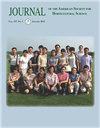A Microscopic and Metabolomic Description of Stip-affected Tissue in New Mexico Pod-type Pepper
IF 1.1
4区 农林科学
Q3 HORTICULTURE
Journal of the American Society for Horticultural Science
Pub Date : 2021-04-20
DOI:10.21273/JASHS05004-20
引用次数: 2
Abstract
Stip is a physiological disorder that affects certain pepper (Capsicum annuum) cultivars, most notably bell-pod types. It has been attributed in the literature to nutrient imbalances, temperature extremes, and/or other environmental stressors. Symptoms present as brown, black, and yellow ovoid-shaped necrotic lesions ≈0.5 to 1.2 cm long by 0.5 cm wide. Between 2014 and 2015, symptomatic and asymptomatic pods were harvested from 15 commercial farms in southern New Mexico. Fluorescent microscopy comparisons of harvested symptomatic tissue revealed a unique fluorescent signature and the absence of chlorophyll. A new spectral peak centered around 560 nm was observed in symptomatic tissue. High-performance liquid chromatography (HPLC) and gas chromatography–mass spectrometry (GC-MS) analyses of these tissues detected significant differences in 13 metabolites, of which several have been associated with fruit maturation and/or senescence. This report represents the first combination of a detailed microscopic description and metabolite profile of field-grown symptomatic plants with this disorder.新墨西哥豆荚型辣椒茎尖影响组织的显微和代谢组学描述
茎尖是一种生理障碍,影响某些辣椒(辣椒)品种,最明显的是钟荚型。在文献中,它被归因于营养失衡、极端温度和/或其他环境压力。症状表现为棕色、黑色和黄色卵形坏死灶,长约0.5 ~ 1.2 cm,宽0.5 cm。在2014年至2015年期间,从新墨西哥州南部的15个商业农场收获了有症状和无症状的豆荚。荧光显微镜比较收获的症状组织揭示了独特的荧光特征和叶绿素的缺乏。在有症状的组织中观察到一个以560nm为中心的新光谱峰。对这些组织进行高效液相色谱(HPLC)和气相色谱-质谱(GC-MS)分析,发现13种代谢物存在显著差异,其中一些代谢物与果实成熟和/或衰老有关。该报告首次结合了田间生长的有症状植物的详细显微描述和代谢物谱。
本文章由计算机程序翻译,如有差异,请以英文原文为准。
求助全文
约1分钟内获得全文
求助全文
来源期刊
CiteScore
3.80
自引率
0.00%
发文量
31
审稿时长
2 months
期刊介绍:
The Journal of the American Society for Horticultural Science publishes papers on the results of original research on horticultural plants and their products or directly related research areas. Its prime function is to communicate mission-oriented, fundamental research to other researchers.
The journal includes detailed reports of original research results on various aspects of horticultural science and directly related subjects such as:
- Biotechnology
- Developmental Physiology
- Environmental Stress Physiology
- Genetics and Breeding
- Photosynthesis, Sources-Sink Physiology
- Postharvest Biology
- Seed Physiology
- Postharvest Biology
- Seed Physiology
- Soil-Plant-Water Relationships
- Statistics

 求助内容:
求助内容: 应助结果提醒方式:
应助结果提醒方式:


